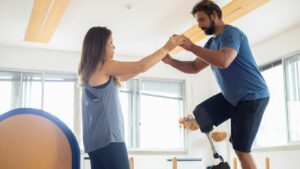 In today’s fast-paced world, maintaining physical health often takes a backseat. Lifestyle physical therapy emerges as a holistic approach, bridging the gap between traditional rehabilitation and everyday wellness. It focuses on integrating movement and exercise into daily routines, promoting not just recovery but also prevention of future injuries.
In today’s fast-paced world, maintaining physical health often takes a backseat. Lifestyle physical therapy emerges as a holistic approach, bridging the gap between traditional rehabilitation and everyday wellness. It focuses on integrating movement and exercise into daily routines, promoting not just recovery but also prevention of future injuries.
This innovative therapy emphasizes personalized strategies that cater to individual lifestyles, making it easier for people to stay active. By prioritizing functional movements and sustainable habits, lifestyle physical therapy empowers individuals to take control of their health. Whether recovering from an injury or seeking to enhance overall well-being, this approach offers valuable insights and actionable steps for a healthier, more active life.
Key Takeaways
- Holistic Approach: Lifestyle physical therapy combines traditional rehabilitation techniques with wellness practices, making physical activity a natural part of daily life.
- Personalized Strategies: This therapy focuses on tailored strategies that consider individual lifestyles, enhancing recovery and preventing future injuries through functional movements.
- Improved Physical and Mental Health: Engaging in lifestyle physical therapy boosts physical health by increasing strength and flexibility, while also enhancing mental well-being through regular exercise and achievable fitness goals.
- Comprehensive Techniques: Techniques include custom exercise regimens, nutritional guidance, and behavioral modifications, promoting sustainable health practices.
- Common Conditions Addressed: The therapy effectively treats chronic pain and mobility issues, providing clients with the tools to maintain active, fulfilling lives.
- Choosing the Right Therapist: Selecting a qualified therapist involves assessing credentials, personalized approaches, specialization, communication skills, and client testimonials to ensure effective care.
Lifestyle Physical Therapy
Lifestyle physical therapy combines traditional rehabilitation techniques with everyday wellness practices. This approach focuses on integrating movement and exercise into daily routines, making physical activity a seamless part of life.
Lifestyle physical therapy emphasizes personalized strategies tailored to individual lifestyles. These strategies promote recovery from injuries while also preventing future issues. Practitioners prioritize functional movements that align with the patient’s daily activities, enhancing the effectiveness of treatment.
Additionally, this therapy encourages the adoption of sustainable habits. By fostering an understanding of how physical health interconnects with daily life, lifestyle physical therapy empowers individuals. It transforms the approach to health into a proactive and consistent practice, ultimately leading to improved overall well-being.
Benefits of Lifestyle Physical Therapy
Lifestyle physical therapy offers numerous benefits, directly impacting physical health and mental well-being. This approach fosters a comprehensive strategy for optimal wellness.
Improved Physical Health
 Improved physical health manifests through various means such as increased strength, flexibility, and endurance. Incorporating tailored exercise programs enhances core stability and promotes better posture. Patients engage in functional movements that directly correlate with their daily tasks, supporting injury recovery and reducing the risk of future issues. Adopting a proactive stance encourages individuals to integrate physical activity naturally into their routines, leading to higher levels of overall fitness.
Improved physical health manifests through various means such as increased strength, flexibility, and endurance. Incorporating tailored exercise programs enhances core stability and promotes better posture. Patients engage in functional movements that directly correlate with their daily tasks, supporting injury recovery and reducing the risk of future issues. Adopting a proactive stance encourages individuals to integrate physical activity naturally into their routines, leading to higher levels of overall fitness.
Enhanced Mental Well-Being
Enhanced mental well-being develops alongside physical improvements. Regular physical activity releases endorphins, which are natural mood lifters. Engaging in exercise also reduces stress, anxiety, and symptoms of depression. By promoting self-efficacy through achievable fitness goals, individuals boost their confidence and improve their overall outlook on life. The integration of physical therapy principles into daily activities cultivates a balanced lifestyle, contributing positively to mental health.
Techniques Used in Lifestyle Physical Therapy
Lifestyle physical therapy employs various techniques that facilitate improved health and wellness. These techniques are designed to integrate into daily routines, promoting sustainable practices.
Exercise Regimens
Exercise regimens form the foundation of lifestyle physical therapy. Customized programs incorporate activities aligned with individual preferences and capabilities. Practitioners prioritize functional movements, which reflect everyday tasks and improve overall functionality.
Key components of exercise regimens include:
- Strength Training: Enhances muscle strength, promotes stability, and supports injury prevention.
- Flexibility Exercises: Increases range of motion, alleviates muscle tension, and reduces the risk of injuries.
- Cardiovascular Activities: Boosts heart health and endurance through aerobic exercises such as walking, running, or cycling.
- Balance Training: Improves coordination, reduces fall risk, and supports overall mobility through targeted exercises.
These elements combine to create a balanced program tailored to each individual’s needs.
Nutritional Guidance
Nutritional guidance complements physical activities in lifestyle physical therapy. Practitioners focus on educating clients about healthy eating habits that support physical activity and overall wellness.
Key aspects of nutritional guidance include:
- Balanced Diet: Ensures appropriate intake of macronutrients and micronutrients for optimal performance and recovery.
- Hydration Strategies: Emphasizes the importance of maintaining hydration to enhance physical performance and overall health.
- Meal Planning: Provides structured approaches to meal preparation, making healthy eating easier and more achievable.
- Behavioral Modifications: Encourages positive changes in eating patterns, helping clients develop sustainable habits over time.
This integration of nutrition and exercise enhances physical health and supports the long-term wellness goals of individuals in lifestyle physical therapy.
Common Conditions Treated
Lifestyle physical therapy addresses several conditions that impact daily living and overall wellness. Among these, chronic pain and mobility issues frequently require specialized treatment strategies.
Chronic Pain
 Chronic pain encompasses persistent discomfort lasting longer than three months. Conditions such as arthritis, fibromyalgia, and lower back pain often contribute to chronic pain. Lifestyle physical therapy employs targeted interventions like therapeutic exercises and manual techniques to alleviate pain. Personalized plans enhance physical function while teaching pain management techniques. These methods empower individuals, enabling them to maintain active lifestyles while effectively handling discomfort.
Chronic pain encompasses persistent discomfort lasting longer than three months. Conditions such as arthritis, fibromyalgia, and lower back pain often contribute to chronic pain. Lifestyle physical therapy employs targeted interventions like therapeutic exercises and manual techniques to alleviate pain. Personalized plans enhance physical function while teaching pain management techniques. These methods empower individuals, enabling them to maintain active lifestyles while effectively handling discomfort.
Mobility Issues
Mobility issues can arise from various sources, including injury, age-related decline, or neurological disorders such as stroke or Parkinson’s disease. Lifestyle physical therapy focuses on improving movement quality and enhancing independence in daily tasks. Practitioners implement specific exercises to increase strength, flexibility, and balance, which helps in regaining lost function. Customized mobility training allows individuals to move more freely, promoting confidence in their physical abilities and facilitating a more active and fulfilling lifestyle.
Choosing the Right Lifestyle Physical Therapist
Selecting a qualified lifestyle physical therapist requires careful consideration. Individuals should prioritize the following factors when making their choice:
- Credentials and Experience
- Verify that the therapist holds the necessary licenses and certifications.
- Review their experience in lifestyle physical therapy, focusing on specific areas that align with personal health needs.
- Personalized Approach
- Ensure the therapist emphasizes personalized treatment plans based on individual goals and lifestyles.
- Look for practitioners who assess unique movement patterns and daily activities to create tailored strategies.
- Specialization
- Identify therapists with specialization in areas relevant to specific conditions, such as chronic pain, sports injuries, or mobility challenges.
- Ensure the therapist integrates both physical therapy and wellness strategies to support comprehensive health.
- Communication Skills
- Assess how effectively the therapist communicates treatment plans and progress.
- Identify therapists who listen to concerns and provide clear explanations of exercise techniques and concepts.
- Location and Availability
- Consider proximity to the therapist’s office for regular sessions and accessibility.
- Evaluate scheduling flexibility to accommodate personal commitments, ensuring continuity of care.
- Client Testimonials
- Review past clients’ testimonials and success stories to gauge effectiveness.
- Seek referrals from healthcare providers or friends who have experienced lifestyle physical therapy.
- Collaborative Approach
- Choose a therapist who collaborates with other healthcare professionals to address broader health issues.
- Ensure that they are willing to communicate with primary care physicians or specialists to provide well-rounded care.
- Technology Integration
- Assess the therapist’s use of technology for tracking progress, such as apps or online platforms.
- Look for therapists who utilize telehealth options for flexibility in treatment sessions.
Choosing a lifestyle physical therapist involves evaluating these critical factors. Making an informed decision ensures a supportive relationship that promotes overall wellness and aligns with personal health objectives.
Rehabilitation with Everyday Wellness
Lifestyle physical therapy offers a transformative approach to health that blends rehabilitation with everyday wellness. By focusing on personalized strategies and functional movements, it empowers individuals to seamlessly integrate physical activity into their daily lives. This proactive method not only addresses existing health issues but also fosters sustainable habits that promote long-term well-being.
With its emphasis on both physical and mental health, lifestyle physical therapy enhances strength and flexibility while boosting mood and reducing stress. By choosing the right therapist, individuals can embark on a journey toward improved health that aligns with their lifestyle and personal goals. Embracing this holistic approach can lead to a more active, fulfilling life.